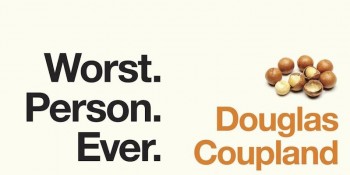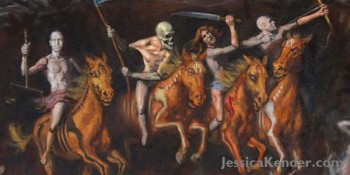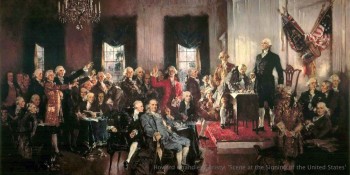Democrat, Republican, Libertarian, Socialist. Political pundits of all philosophies like to argue they are on the side of the Founding Fathers of the United States. This idea, no matter the purveyor’s political persuasion, is a myth.
The Founding Fathers were not a monolith. They were a collection of incredible — but flawed — men of varying degrees of intellect and a wide range of philosophical, theological, and political beliefs. George Washington and Thomas Jefferson rarely agreed. Alexander Hamilton and John Adams were of the same political party and could almost never get along. Benjamin Franklin’s views of the world contrasted sharply with those of the Founding Fathers from Virginia. These men were people with opinions as wide-ranging as our own.
Saying you agree with the Founding Fathers is bold, since even deciding who counts as a Founder can be difficult. For the sake of our discussion, the Founding Fathers will be defined as the men who helped to spark the American Revolution and worked to establish the new government formed in 1787. This includes the men who argued against the Declaration of Independence, like John Dickinson, and who opposed the Constitution, such as Patrick Henry. In my view, the Founding Generation ended with the deaths of Adams and Jefferson on July 4, 1826, only a year after the conclusion of the presidency of the last Founding Father, James Monroe, and 50 years after the date of Independence.
Using this formula, we see that there are 60 years’ worth of leaders included in the Founding Generation. These were men who identified with 13 different colonies, were born across the span of the 18th century, and had very different stories that defined who they were.
Washington, Jefferson, Henry, James Madison, and others were born into the Virginia planter aristocracy. These bastions of liberty were actually men of almost noble birth who expected men of the underclass to defer to their judgement. This view caused some strong personality clashes when Washington led the Continental Army, which was full of Massachusetts men, who were raised in a world of comparable equality and were filled with the “leveling spirit.”
These Tidewater gentlemen evolved over time, especially through the Revolution and the Washington administration, but much of their Virginia breeding was hard to shake. Jefferson, despite being the strongest advocate for the people among the planter class, was still a slave owner after all.
Even during the time of the Revolution, “democracy” was a dirty word and shorthand for what could go wrong without proper leadership. Madison, the so-called “Father of the Constitution,” feared that unfettered democracy would create anarchy. He argued for a grand republic, full of conflicting interests, that would force compromise since a majority would never be attainable.
Adams, who spent his presidency opposing Madison’s new political party, shared a similar view about democracy. He was perhaps the best representative of the Bostonian view of America, which was opposed at the same time to aristocracy and the rabble. It was Adams who pushed heavily for a government of checks and balances to thwart the power of the minority or the majority to oppress their natural opponents.
Adams was perhaps the most devoutly religious Founding Father. Despite this, he is often associated with the Treaty of Tripoli, which he signed in 1797, that stated his belief that the United States was not founded on the Christian religion. Yet Adams was a strong Christian. Other founders were Deists, meaning they believed in a god, but also that this god was not a part of everyday human affairs. Thomas Paine was perhaps Deism’s strongest advocate, but the philosophy also heavily influenced Jefferson and Franklin.
Paine and Jefferson often found themselves in agreement, but Adams and Franklin certainly did not. While there was a strong respect between them, the two personalities clashed greatly when they were together in Europe to negotiate deals for the former colonies. The two giants of the American Revolution were just too different.
Franklin was a unique animal in world history. Historian H. W. Brands has dubbed Franklin the First American; he lived a life that is much more familiar to the modern American. Unlike the Virginia planters, Franklin was not born into privilege, but into the strict, Puritanical society of Boston. Being raised in the Calvinist tradition, Franklin maintained a strong sense of morality in terms of the treatment of others, but harbored a rebellious opinion against entrenched power, whether it be the Penn family, established churches, or, eventually, the British government.
But Franklin did not always oppose the Brits and is a perfect example of how Revolutionary leaders were actually fairly conservative compared to later revolutionaries, like the French. Franklin was, for most of his life, an advocate for a stronger British Empire. He believed that a king and a populist government were not mutually exclusive. Franklin only accepted independence when all other options seemed hopeless. Certainly, this is hard for modern Americans to understand, which is true of many aspects of the Founding Fathers due to the intervention of some 250 years.
Indeed, it is impossible to define the philosophies of the Founding Generation using modern terminology. Alexander Hamilton, who was considered a conservative at the time, supported a strong federal government, advocated for a controlling monetary policy, and pushed his financial system as a way to spawn economic growth for the young nation. Jefferson, considered a liberal, favored an agrarian society of small farmers, free of government intervention wherever possible, and argued that the Constitution granted the federal government almost no powers whatsoever. Yet, on the opposite side of the same coin, Hamilton was considered too pro-business and literally lived on Wall Street, while Jefferson hated big business and supported the struggle of the so-called average man. If you define yourself on either side of the Democrat/Republican divide, you would find it impossible to agree with either Jefferson or Hamilton completely.
Jefferson and Hamilton led the first opposing political parties in American history. It was their philosophies that created the disputing views we hold of the bedrock of our government, the U.S. Constitution. We hold the Constitution to be a sacred document, as though it is the perfect creation of a divine being. Many judges and Supreme Court justices believe that the Founders had an original intent for each word of the document; therefore, the Constitution is a rigid document with specific rules, rather than the vague, evolving document that liberal justices see.
But there can be no “original intent” as there were so many originators of the document. No part of the Constitution can be attributed to a single brain. The Founders were of very different minds with regards to the government they wished to create and run. Henry and Samuel Adams outright refused to be involved with the Constitution-making process. They favored the Articles of Confederation, which held the government together from the time of the Revolutionary War.
The Constitutional Convention, which took place in Philadelphia in 1787, brought together a large group of diverse men with different goals. Some wanted only to adjust the Articles. Others wanted to start from scratch. Madison offered the Virginia Plan, a proposal for a bicameral legislature with a House and a Senate given representation proportionate to population. Others pushed for the New Jersey Plan, which gave representation by state, meaning small states and large states would have equal power in the federal government. Hamilton pushed for an elected monarch-for-life. Every side of this argument combined to give us the mixed Congressional system, balanced by a strong executive, that we have today.
And when the Constitution was completed, almost no one was completely satisfied. So when you say you are “pro-Constitution, like the Founders,” remember that some of them weren’t even in favor of creating the Constitution.
Hamilton and Madison did more than anyone to define what the Constitution would accomplish through their collaboration on the Federalist Papers. Yet for years afterward, these two titans argued with each other over the meaning of the ratified document. How is it that the two men who are arguably most responsible for our Constitution and the way it has been interpreted couldn’t even agree on it, yet men like Justice Antonin Scalia claim to know the original intent of the document?
Our Constitution was created as a compromise and we should govern in that spirit, not claim to know the exact meaning of the text, trampling over others who disagree. The Constitutional arguments we have today have been around since 1787 and were themselves extensions of debates that have raged for centuries about the role of government in general.
If the Founders were alive today, Washington, Franklin, Hamilton, Jefferson, Madison, and the Adams cousins would not be able to agree on how to define a pizza, let alone what toppings to put on it. That’s not to say we shouldn’t look to these iconic men for inspiration and guidance. The Revolution and the government they created are magnificent works of human endeavor and compromise. We cannot, however, be bound by their words to a point of paralysis.
And we cannot accept the idea that the Founding Fathers as a whole would agree or disagree with a certain viewpoint. They were men of their times, bound by context and situation. We can say that Jefferson would be a libertarian, Hamilton a neoconservative, Franklin a Democrat, but would those definitions be fair to the complex men we exalt? Absolutely not.
These men (and let’s not forget the contributions of Abigail Adams) spent their lives reading, writing, studying, and thinking, and came to very different conclusions about what America could and should be. We should be inspired by that spirit and begin our own journeys of philosophical discovery to determine what works best for our time and our problems. Otherwise, our minds will continue to live in a generational tyranny, blindly following the precedents set by men who have been gone for 200 years and have no sense of our world. Follow their examples, learn from their wisdom, but don’t be constrained by their works.




